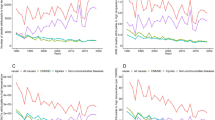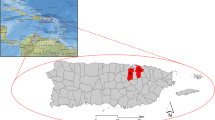Abstract
Climate change and health are inextricably linked, especially the role of ambient temperature. This study aimed to analyze the non-communicable disease (NCD) burden attributable to low temperature globally, regionally, and temporally using data from the Global Burden of Disease (GBD) study 2019. Globally, in 2019, low temperature was responsible for 5.42% DALY and 7.18% death of NCDs, representing the age-standardized disability-adjusted life years (DALY) and death rates (per 100,000 population) of 359.6 (95% uncertainty intervals (UI): 306.09, 416.88) and 21.36 (95% UI:18.26, 24.74). Ischemic heart disease was the first leading cause of DALY and death resulting from low temperature, followed by stroke. However, age-standardized DALY and death rates attributable to low temperature have exhibited wide variability across regions, with the highest in Central Asia and Eastern Europe and the lowest in Caribbean and Western sub-Saharan Africa. During the study period (1990–2019), there has been a significant decrease in the burden of NCDs attributable to low temperature, but progress has been uneven across countries, whereas nations exhibiting high sociodemographic index (SDI) declined more significantly compared with low SDI nations. Notably, three nations, including Uzbekistan, Tajikistan, and Lesotho, had the maximum NCDs burden attributed to low temperature and displayed an upward trend. In conclusion, ambient low temperature contributes to substantial NCD burden with notable geographical variations.






Similar content being viewed by others
Data availability
The datasets used and/or analyzed during the current study are available from the corresponding author on reasonable request.
Abbreviations
- NCDs:
-
Non-communicable diseases
- GBD:
-
Global Burden of Disease Study
- DALY:
-
Disability-adjusted life year
- SDI:
-
Sociodemographic index
- COPD:
-
Chronic obstructive pulmonary disease
- CKD:
-
Chronic kidney diseases
- UI:
-
Uncertainty interval
- CI:
-
Confident intervals
- AAPC:
-
Average annual percent change
References
Achebak H, Devolder D, Ballester J (2019) Trends in temperature-related age-specific and sex-specific mortality from cardiovascular diseases in Spain: a national time-series analysis. Lancet Planet Health 3:e297–e306
Arbuthnott K, Hajat S, Heaviside C, Vardoulakis S (2018) What is cold-related mortality? A multi-disciplinary perspective to inform climate change impact assessments. Environ Int 121:119–129
Bhatnagar A (2017) Environmental determinants of cardiovascular disease. Circ Res 121:162–180
Chen RJ, Yin P, Wang LJ, Liu C, Ni Y, Wang WD et al (2018) Association between ambient temperature and mortality risk and burden: time series study in 272 main Chinese cities. BMJ 363:k4306
Cheng J, Xu Z, Bambrick H, Su H, Tong S, Hu W (2019) Impacts of exposure to ambient temperature on burden of disease: a systematic review of epidemiological evidence. Int J Biometeorol 63:1099–1115
Conlon KC, Rajkovich NB, White-Newsome JL, Larsen L, O’Neill MS (2011) Preventing cold-related morbidity and mortality in a changing climate. Maturitas 69:197–202
Couser WG, Remuzzi G, Mendis S, Tonelli M (2011) The contribution of chronic kidney disease to the global burden of major noncommunicable diseases. Kidney Int 80:1258–1270
Diaz J, Lopez-Bueno JA, Saez M, Miron IJ, Luna MY, Sanchez-Martinez G et al (2019) Will there be cold-related mortality in Spain over the 2021–2050 and 2051–2100 time horizons despite the increase in temperatures as a consequence of climate change? Environ Res 176:108557
Ding Z, Li LJ, Wei RQ, Dong WY, Guo P, Shaoyi Yang SY et al (2016) Association of cold temperature and mortality and effect modification in the subtropical plateau monsoon climate of Yuxi, China
Ebi KL, Mills D (2013) Winter mortality in a warming climate: a reassessment. Wires Clim Change 4:203–212
Friel S, Bowen K, Campbell-Lendrum D, Frumkin H, McMichael AJ, Rasanathan K (2011) Climate change, noncommunicable diseases, and development: the relationships and common policy opportunities. Annu Rev Public Health 32:133–147
Gasparrini A, Guo YM, Masahiro H, Eric L, Antonella Z, Joel S et al (2015) Mortality risk attributable to high and low ambient temperature: a multicountry observational study. Lancet 386:369–375
Gasparrini A, Guo Y, Sera F, Vicedo-Cabrera AM, Huber V, Tong S et al (2017) Projections of temperature-related excess mortality under climate change scenarios. Lancet Planet Health 1:e360–e367
GBD 2019 Diseases and Injuries Collaborators (2020) Global burden of 369 diseases and injuries in 204 countries and territories, 1990–2019: a systematic analysis for the Global Burden of Disease Study 2019. Lancet 396:1204–1222
GBD 2019 Risk Factors Collaborators (2020) Global burden of 87 risk factors in 204 countries and territories, 1990-2019: a systematic analysis for the Global Burden of Disease Study 2019. Lancet 2020(396):1223-1249
Ghorbanian A, Jafari AJ, Shahsavani A et al (2020) Quantification of mortality and morbidity in general population of heavily-industrialized city of Abadan: Effect of long-term exposure. Journal of Air Pollution and Health 5:171–180
Guo YM, Gasparrini A, Armstrong B, Li SS, Tawatsupa B, Tobias A et al (2014) Global variation in the effects of ambient temperature on mortality: a systematic evaluation. Epidemiology 25:781–789
Hajizadeh Y, Jafari N, Fanaei F et al (2021) Spatial patterns and temporal variations of traffic-related air pollutants and estimating its health effects in Isfahan city. Iran J Environ Health Sci Eng 19:781–791
Hu K, Guo Y, Hochrainer-Stigler S, Liu W, See L, Yang X et al (2019) Evidence for urban-rural disparity in temperature-mortality relationships in Zhejiang Province. China Environ Health Perspect 127:37001
Iniguez G, Roye D, Tobias A (2021) Contrasting patterns of temperature related mortality and hospitalization by cardiovascular and respiratory diseases in 52 Spanish cities. Environ Res 192:110191
Jha V, Garcia-Garcia G, Iseki K, Li Z, Naicker S, Plattner B et al (2013) Chronic kidney disease: global dimension and perspectives. Lancet 382:260–72
John MW, Isaac MH, David WJ, Thompson KET, John EW (2014) Global warming and winter weather. Science 343:729–730
Kermani M, Jafaria AJ, Gholami M et al (2020) Investigation of relationship between particulate matter (PM2.5) and meteorological parameters in Isfahan. Iran J Air Pollut Health 5:97–106
Kermani M, Jafaria AJ, Gholami M et al (2021) Characterisation of PM2.5- bound PAHs in outdoor air of Karaj megacity: the effect of meteorological factors. International Journal of Environmental Analytical Chemistry.
Kim HJ, Fay MP, Feuer EJ et al (2000) Permutation tests for joinpoint regression with applications to cancer rates. Stat Med 19:335–351
Lam HCY, Chan JCN, Luk AOY, Chan EYY, Goggins WB (2018) Short-term association between ambient temperature and acute myocardial infarction hospitalizations for diabetes mellitus patients: a time series study. PLoS Med 15:e1002612
Li G, Li Y, Tian L, Guo Q, Pan X (2018) Future temperature-related years of life lost projections for cardiovascular disease in Tian**. China Sci Total Environ 630:943–950
Masato G, Bone A, Charlton-Perez A, Cavany S, Neal R, Dankers R et al (2015) Improving the health forecasting alert system for cold weather and heat-waves in England: a proof-of-concept using temperature-mortality relationships. PLoS ONE 10:e0137804
Moghadamnia MT, Ardalan A, Mesdaghinia A, Keshtkar A, Naddafi K, Yekaninejad MS (2017) Ambient temperature and cardiovascular mortality: a systematic review and meta-analysis. Peer J 5:e3574
Murray CJL, Ezzati M, Flaxman AD (2012) The Global Burden of Disease Study 2010: design, definitions, and metrics. Lancet 380:2063–2066
Patrick LK, Joel S, Mathilde P, Elisaveta P, Alain LT, Sylvia M et al (2015) Winter season mortality: will climate warming bring benefits? Environ Res Lett 10(6):064016
Paul W, Sam P, Ben A, Astrid F, Sari K, Punam M et al (2004) Vulnerability to winter mortality in elderly people in Britain: population based study. BMJ 329:647
Ramon M, Peter LS, Patricia S, Shah E, Enrique V, Pedro O et al (2020) Trends in premature avertable mortality from non-communicable diseases for 195 countries and territories, 1990–2017: a population-based study. Lancet Glob Health 8:e511–e523
Roth GA, Mensah GA, Johnson CO, Addolorato G, Ammirati E, Baddour LM et al (2020) Global burden of cardiovascular diseases and risk factors, 1990–2019: update from the GBD 2019 Study. J Am Coll Cardiol 76:2982–3021
Ryti NR, Guo Y, Jaakkola JJ (2016) Global association of cold spells and adverse health effects: a systematic review and meta-analysis. Environ Health Perspect 124:12–22
Scovronick N, Sera F, Acquaotta F, Garzena D, Fratianni S, Wright CY et al (2018) The association between ambient temperature and mortality in South Africa: A time-series analysis. Environ Res 161:229–235
Silveira IH, Oliveira BFA, Cortes TR, Junger WL (2019) The effect of ambient temperature on cardiovascular mortality in 27 Brazilian cities. Sci Total Environ 691:996–1004
Son JY, Gouveia N, Bravo MA, de Freitas CU, Bell ML (2016) The impact of temperature on mortality in a subtropical city: effects of cold, heat, and heat waves in Sao Paulo. Brazil Int J Biometeorol 60(1):113–121
Sotiris V, Keith D, Shakoor H, Clare H, Bernd E, Anthony JM (2014) Comparative assessment of the effects of climate change on heat- and cold-related mortality in the United Kingdom and Australia. Environ Health Perspect 122:1285–1292
UN Department of Economic and Social Affairs Population Division (2019) World population prospects 2019: Highlights. New York, NY: United Nations, 2019. https://population.un.org/wpp/Publications/Files/WPP2019_Highlights.pdf
Vicedo-Cabrera AM, Sera F, Guo Y, Chung Y, Arbuthnott K, Tong S et al (2018) Multicounty analysis on potential adaptive mechanisms to cold and heat in a changing climate. Environ Int 111:239–246
WHO (2018) Time to deliver: report of the WHO Independent High-level Commission on Noncommunicable Diseases. World Health Organization, Geneva
Yan B, Chebana F, Masselot P, Campagna C, Gosselin P, Ouarda T (2020) A cold-health watch and warning system, applied to the province of Quebec (Canada). Sci Total Environ 741:140188
Yin Q, Wang JF, Ren ZP, Li J, Guo YM (2019) Map** the increased minimum mortality temperatures in the context of global climate change. Nat Commun 10:4640
Acknowledgements
We highly appreciate the work by the GBD 2019 collaborators.
Funding
This work was supported by the National Natural Science Foundation of China (grant number: 81773518).
Author information
Authors and Affiliations
Contributions
Conceptualization: Jian Song, Jian Cheng; data curation: Jian Song, Wei Qin, Rubing Pan, Weizhuo Yi; formal analysis: Jian Song, Wei Qin; methodology: Jian Song, Wei Qin, Jian Cheng, Hong Su; Software: Jian Song, Rubing Pan, Wei Qin; supervision: Jian Song, Shasha Song, Jian Cheng, Hong Su; validation: Jian Song, Wei Qin, Shasha Song; visualization: Jian Song, Weizhuo Yi; writing — original draft: Jian Song; writing — review and editing: Jian Song, Jian Cheng, Hong Su.
Corresponding author
Ethics declarations
Ethics approval
This study was approved by the Ethical Committee of Anhui Medical University (Hefei, Anhui, China).
Consent to participate
Not applicable (this study does not contain any individual person’s data in any form).
Consent for publication
The authors declare that they agree with the publication of this paper in this journal.
Competing interests
The authors declare no competing interests.
Additional information
Responsible Editor: Lotfi Aleya
Publisher's note
Springer Nature remains neutral with regard to jurisdictional claims in published maps and institutional affiliations.
Supplementary Information
Below is the link to the electronic supplementary material.
Rights and permissions
About this article
Cite this article
Song, J., Qin, W., Pan, R. et al. A global comprehensive analysis of ambient low temperature and non-communicable diseases burden during 1990–2019. Environ Sci Pollut Res 29, 66136–66147 (2022). https://doi.org/10.1007/s11356-022-20442-4
Received:
Accepted:
Published:
Issue Date:
DOI: https://doi.org/10.1007/s11356-022-20442-4




